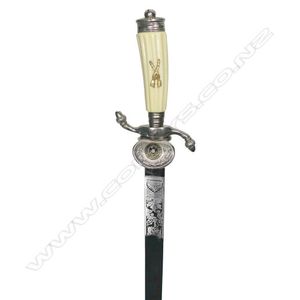German WWII Shooting Dagger with Hunting Scenes
A World War II German Rifle Association (Deutscher - Scuutzen-Verband) 'Shooting Dagger', the hilt with nickel plated pommel, S-quillon crossguard with acorn finials and clamshell pinned with the Association's insignia; the white fluted celluloid grip pinned with gilt metal crossed rifles insignia; the 39.5 cm blade etched and blacked either side with forestry and hunting scenes and manufacturer's mark of E. & F. Horster, Solingen; the black leather scabbard with plated chape and mouth, complete with leather belt frog.
You must be a subscriber, and be logged in to view price and dealer details.
Subscribe Now to view actual auction price for this item
When you subscribe, you have the option of setting the currency in which to display prices to $Au, $US, $NZ or Stg.
This item has been sold, and the description, image and price are for reference purposes only.
- Celluloid - In 1864 an American scientist by the name of Parkes mixed camphor with nitrocellulose, etc. The result was what came to be known as "celluloid", the first form of plastic, and a product for which Parkes could find no use.
Some time later when the supplies of ivory for making billiard balls were becoming difficult to obtain, an inventor produced a perfect billiard ball from a mould using "celluloid".
Toys, dolls and other products such as combs, cutlery handles and costume jewellery made from celluloid began appearing on the market from 1913 and continued to do so until the early 1950s by which time it was superseded by more modern products due to safety concerns because it was highly flammable and brittle product. - Finial - An architectural decoration, found on the upper parts of of an object. On furniture they are usually found on pediments, canopies and shelf supports. On smaller ceramic or silver items, such as spoons, they may decorate the top of the item itself, or the lid or cover where they provide a useful handle for removal.
Finials have a variety of shapes and forms. They may be urn-shaped, baluster shaped round or spiral, but usually taper into an upper point. Many real life shapes may also be used as finials, such as pineapples, berries, pinecones, buds, lotus and acorns. Sometimes animals such as a lion are depicted, or fish and dolphins.
This item has been included into following indexes:
